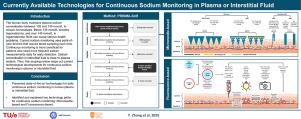Currently available technologies for continuous sodium monitoring in plasma or interstitial fluid: A scoping review
IF 4.9
Q1 CHEMISTRY, ANALYTICAL
引用次数: 0
Abstract
The human body maintains plasma sodium concentration within a narrow range of 135 to 145 mmol/L to ensure homeostasis. Being outside this range denotes hyponatremia (below 135 mmol/L) or hypernatremia (above 145 mmol/L), which can cause serious health problems. Current sodium monitoring is performed using point-of-care devices, which require blood sampling every time. It is cumbersome and uncomfortable for patients who require frequent sodium measurements daily. It would be ideal to continuously monitor plasma sodium concentration to reduce burden and detect abnormalities earlier. The sodium concentration in interstitial fluid is close to plasma sodium. Thus, this scoping review presents the current technological developments for continuous sodium monitoring (CSM) in plasma or interstitial fluid. The study followed the Preferred Reporting Items for Systematic Reviews and Meta-Analysis extension for Scoping Reviews (PRISMA-ScR) checklist. 11 articles that presented technologies for the continuous monitoring of sodium concentrations in plasma or interstitial fluid with at least a technology readiness level of four were included for review. Seven of them presented microneedle(MN)-based solutions for CSM, and the remaining four were fluorescence(FS)-based. MN-based sodium sensors are all-solid-state sodium ion-selective electrodes designed as MN arrays or standalone MNs. FS-based CSM technologies inject sodium-sensitive fluorophores into the bloodstream or subcutaneously to reflect local sodium concentrations. Comparison of these two technological paths based on expected patient experience revealed that MN-based technologies appear more feasible for daily use and promising for further development due to their minimal invasiveness and compact wearability.

血浆或间质液连续钠监测的现有技术:范围综述
人体将血浆钠浓度维持在135 ~ 145 mmol/L的狭窄范围内,以保证体内平衡。超出这个范围表示低钠血症(低于135毫摩尔/升)或高钠血症(高于145毫摩尔/升),这可能导致严重的健康问题。目前的钠监测是使用即时护理设备进行的,每次都需要采血。对于每天需要频繁测量钠含量的患者来说,这种方法既麻烦又不舒服。持续监测血浆钠浓度,减轻负担,及早发现异常,是理想的。间质液钠浓度与血浆钠浓度相近。因此,本文综述了血浆或间质液连续钠监测(CSM)的最新技术进展。该研究遵循了系统评价的首选报告项目和范围评价的元分析扩展(PRISMA-ScR)清单。11篇介绍血浆或间质液中钠浓度连续监测技术的文章被纳入审查,技术成熟度至少为4级。其中7种是基于微针(MN)的CSM溶液,其余4种是基于荧光(FS)的CSM溶液。锰基钠传感器是全固态钠离子选择性电极,设计为锰阵列或独立的锰。基于fs的CSM技术将钠敏感荧光团注入血液或皮下以反映局部钠浓度。基于预期患者体验的两种技术路径的比较表明,基于mn的技术似乎更适合日常使用,并且由于其最小的侵入性和紧凑的可穿戴性,具有进一步发展的前景。
本文章由计算机程序翻译,如有差异,请以英文原文为准。
求助全文
约1分钟内获得全文
求助全文
来源期刊

Sensing and Bio-Sensing Research
Engineering-Electrical and Electronic Engineering
CiteScore
10.70
自引率
3.80%
发文量
68
审稿时长
87 days
期刊介绍:
Sensing and Bio-Sensing Research is an open access journal dedicated to the research, design, development, and application of bio-sensing and sensing technologies. The editors will accept research papers, reviews, field trials, and validation studies that are of significant relevance. These submissions should describe new concepts, enhance understanding of the field, or offer insights into the practical application, manufacturing, and commercialization of bio-sensing and sensing technologies.
The journal covers a wide range of topics, including sensing principles and mechanisms, new materials development for transducers and recognition components, fabrication technology, and various types of sensors such as optical, electrochemical, mass-sensitive, gas, biosensors, and more. It also includes environmental, process control, and biomedical applications, signal processing, chemometrics, optoelectronic, mechanical, thermal, and magnetic sensors, as well as interface electronics. Additionally, it covers sensor systems and applications, µTAS (Micro Total Analysis Systems), development of solid-state devices for transducing physical signals, and analytical devices incorporating biological materials.
 求助内容:
求助内容: 应助结果提醒方式:
应助结果提醒方式:


